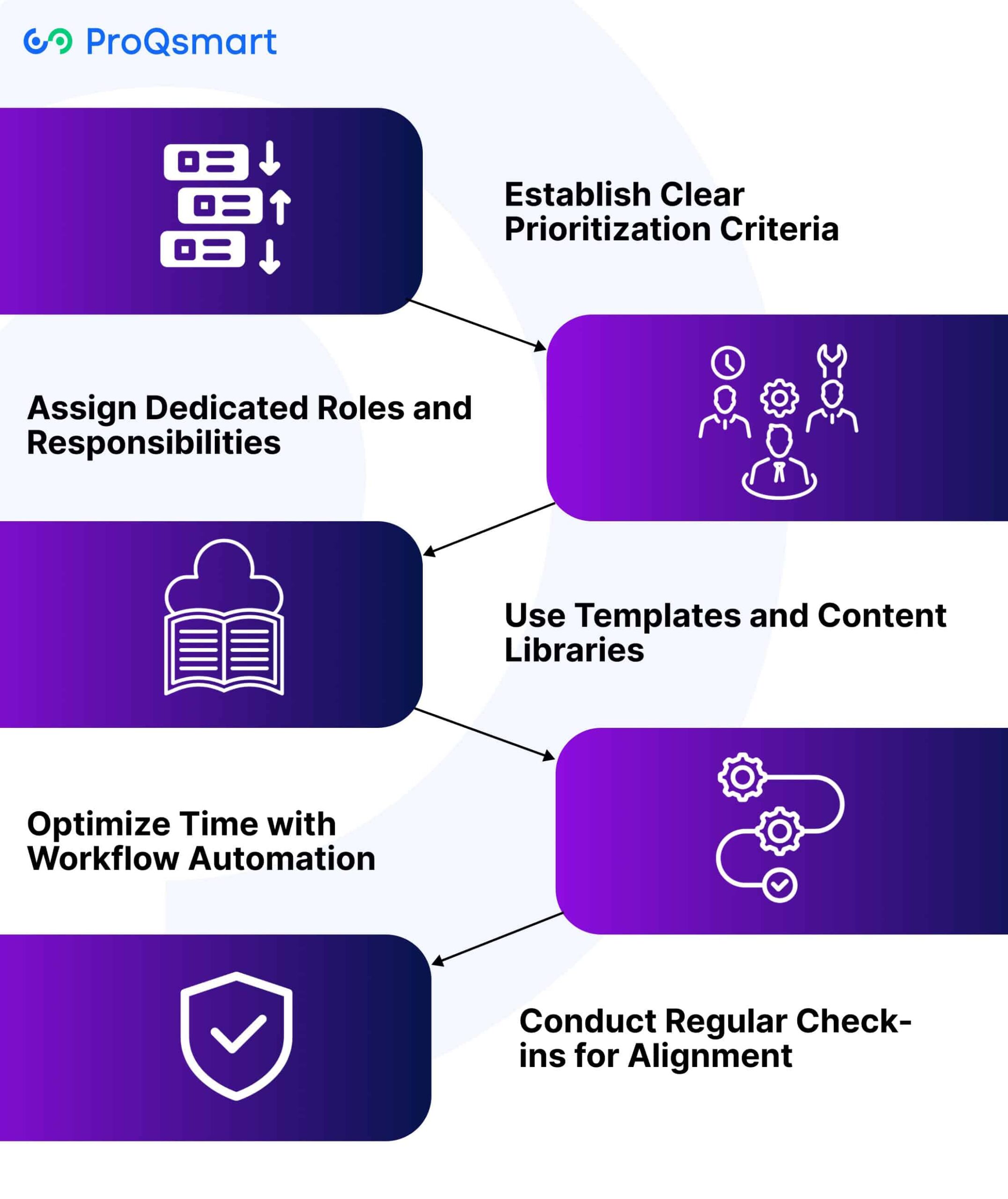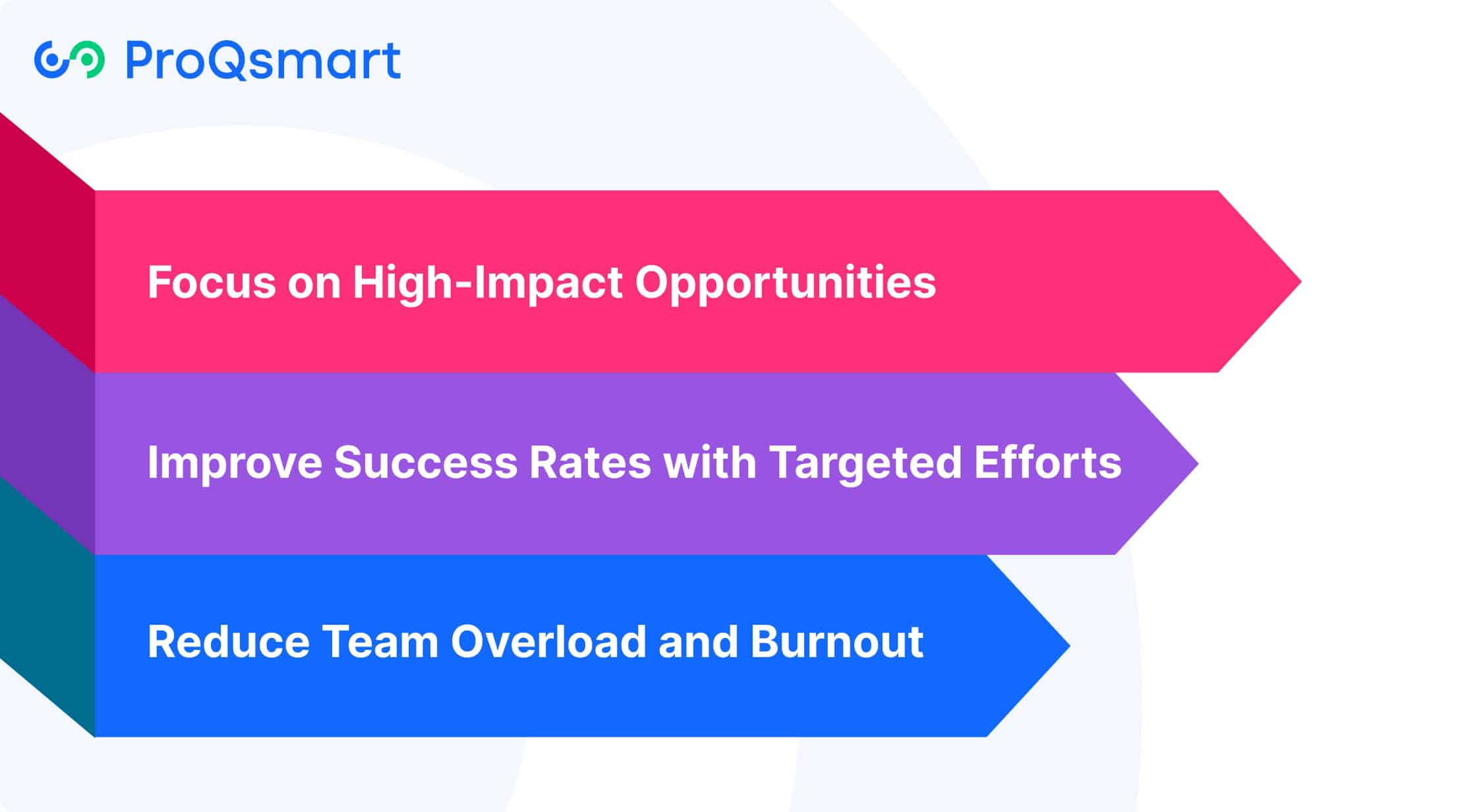A Request for Proposal, or RFP, is a standard formal document. Organizations use it to request vendors or service providers to submit proposals to carry out projects or provide specified services.
It provides detailed information about the project scope, selection criteria, and submission requirements, helping to create a clear and competitive selection process. Ideally meant to simplify the procurement process, RFPs allow businesses to compare multiple businesses, evaluate their abilities, and select the most qualified option.
They’re prevalent in industries such as construction, technology, and manufacturing where customized solutions are required. Beyond better supplier responses, a well-structured RFP lays the groundwork for mutually beneficial, long-term partnerships built on shared goals and expectations.
Whether you’re a buyer or a vendor, understanding the basics of an RFP is crucial. That understanding will put you in the position to be the catalyst for great project results.
Understanding RFP Complexity
The Request for Proposal (RFP) process has long been a staple of procurement practices, inundating the industry with complex documents and multi-layered stipulations. These documents often feature detailed specifications, compliance requirements and detailed questionnaires, many over 1,000 questions long.
Often, even this amount can be insufficient to convey project intricacies. This complexity requires a detailed and careful approach to avoid missing any key elements or not doing thorough work. When buyers issue RFPs through email with attachments, they get into trouble.
Scoring responses by hand can quickly become an arduous task, particularly when attempting to score each vendor on their own merits. All too often these organizations are in crisis mode, using person-hours measured in months to work through backlogs and avoid user frustration.
Managing Resource Limitations
Trouble-free RFP management starts with understanding the strengths of your team. By identifying skill gaps, firms can better deploy resources along each stage of the pipeline.
For example, cross-training staff to perform a variety of tasks can increase organizational nimbleness, a critical factor when responding to large RFP questionnaires. Focusing on the highest value RFPs first guarantees the best use of our limited resources and gives us the flexibility to schedule secondary projects in the future.
Planning is essential, especially since the RFP process can take anywhere from six weeks to infinite time thereafter.
Ensuring Quality and Consistency
A clear, standardized review process across all departments involved is critical to upholding the quality of your RFP responses. This means developing response templates to make sure every element aligns with organizational standards.
This collaboration across teams helps create shared insights and enhances consistency, making the response more appealing.
How to Manage Multiple RFPs?

Handling several RFPs (Request for Proposals) at once requires a methodical plan that helps to maintain both productivity and excellence. It takes intentionality and clear prioritization, strategic resource allocation and the thoughtful integration of tools and technology to create efficiencies.
Here, we look at some practical ways to make this sometimes daunting task a bit easier.
1. Evaluate and Prioritize RFPs
Evaluation criteria is key when juggling multiple RFPs. Look at strategic fit, potential business impact and your resource constraints to figure out which RFPs deserve your time and effort.
For example, give preference to RFPs that match your organization’s strategic direction or higher-value RFPs. Continually evaluate these priorities as new RFPs come in or project circumstances change.
This consistency helps avoid missed opportunities and ensures that resources are being used in the most effective manner.
2. Allocate Resources Effectively
Provide clear roles and responsibilities for your team members to create a sense of ownership. For instance, assign one person to manage compliance and requirements while other team members work on creating detailed technical proposals.
Keeping track of everyone’s workload to ensure a fair redistribution of tasks, while avoiding burnout and overload, is very important. During projects that need specialized expertise, outside consultants supplement your staff, helping you meet deadlines without overloading your employees.
3. Standardize Processes for Efficiency
Having a documented, standardized process stays in play and avoids reinventing the wheel each time. Descriptive short key steps could be first RFP review, preparation and approval phase.
Develop templates for sections you find yourself needing often, like executive summaries or pricing structures, to streamline the process. Automation and expertise tools such as ProQsmart’s AI-driven e-tendering system make workflow easier, more accurate and of a higher and more uniform quality.
4. Leverage Technology for Automation
Technology is the backbone to successful RFP management. Use platforms like ProQsmart to automate and streamline the most time-consuming tasks, including document management and compliance checks.
Tools such as Loopio’s content library or AI-driven systems save time through automation and improve consistency. For instance, ProQsmart combines real-time collaboration and supplier evaluation to bring greater transparency and smarter decision-making to the process.
5. Communicate Clearly with Teams
Maintain clarity through customer communication hubs. Regular check-ins help keep you aligned and offer opportunities to discuss and overcome challenges.
Make things as simple as possible, avoid jargon to minimize confusion, and invite honest conversations to exchange knowledge. A common platform, such as ProQsmart, increases transparency and encourages cooperation, ensuring all stakeholders are on the same page.
6. Track Progress with Tools
Track RFP progress using tools like ProQsmart to visualize tasks. To keep the energy up, establish milestones like submission drafts or final reviews.
Combined with ProQsmart’s workflow automation and tracking capabilities, teams can ensure they stay on top of deadlines and prevent any costly last-minute rushes.
7. Review and Improve Continuously
Post-submission debriefs can be incredibly valuable. Taking a look at what went into making something a success or what requires work.
Future efforts can be better informed by feedback from tools such as ProQsmart’s supplier performance monitoring. A culture of continuous improvement improves efficiency and increases the win rate.
“Well-structured RFPs have a lot to recommend them. They lead to better project outcomes, better alignment with project goals, and a greater likelihood that the most qualified contractor is selected”.
Download Editable RFP Template for your industry!
Key Strategies for Multi-RFP Management

Effectively managing multiple RFPs involves a systematic approach that prioritizes project requirements, allocates resources, and optimizes the proposal process. Success in this arena means winning those highly-prized contracts while positioning more competitively for future procurement decisions.
Establish Clear Prioritization Criteria
Establishing clear criteria to use for prioritizing RFPs provides a strong framework for making strategic decisions. Criteria such as potential revenue, strategic alignment, and resource requirements help teams prioritize and hone in on the most impactful opportunities.
Transparency is important—being upfront about these criteria helps make sure that your entire team is on the same page. Continuous prioritization helps enable teams to stay aligned with changing business objectives and market realities, promoting greater agility.
Assign Dedicated Roles and Responsibilities
Clear role assignments eliminate duplication of efforts, which greatly enhances accountability. For example, creating specialized RFP teams with clearly delineated roles enables execution driven by expertise.
Technical writers, financial analysts, and compliance managers can all work on their sections with confidence. Collaboration is key. Tucked under collaboration is a theme that runs through everything—collaborating with diverse teams makes for robust, competitive proposals.
Use Templates and Content Libraries
Vetted, standardized templates and a robust content library help alleviate wasted time on redundant work. Creating a library filled with pre-written content for sections such as corporate background, safety, or past project experience is helpful in maximizing efficiency.
Frequent updates ensure that our practices are always in line with current best practices. Ideas from team members continue to make the repository more robust and applicable.
Optimize Time with Workflow Automation
Automation tools streamline labor-intensive tasks such as document management and approvals. By automating these processes, organizations reduce errors and free up resources for strategic activities.
ProQsmart, for instance, integrates AI-driven automation to simplify e-tenders, manage subcontractors, and ensure compliance, providing unmatched workflow optimization. Regular evaluations of automation tools help fine-tune their impact and sustain efficiency gains.
Conduct Regular Check-ins for Alignment
Regular team meetings are a great place to share progress, discuss challenges, and collaborate on solutions. These joint working sessions build alignment on common goals, identify where things may bottleneck, and encourage direct communication.
Benefits of RFP Prioritization

Prioritizing Requests for Proposal (RFPs) is a crucial aspect of the procurement decision process. An effective RFP helps organizations invest resources efficiently, increase the success rate of proposals, and protect team health. By focusing on opportunities with the greatest impact, teams can achieve measurable gains in efficiency and outcomes.
Focus on High-Impact Opportunities
Figuring out which RFPs best match your strategic big picture goals is key to getting the most bang for your buck. Consider using a weighted scoring system to score your categories to address each one efficiently.
This strategy helps your staff focus on the most promising projects—those that will deliver the most benefit—while steering clear of lower value projects. With the ability to automate workflows, ProQsmart creates a streamlined process. It further makes comparisons across vendors easier, helping you focus on the most high-value bids.
Improve Success Rates with Targeted Efforts
RFP prioritization helps sharpen your focus on crafting more tailored responses that speak directly to the unique needs of your clients. Learning lessons from other successful proposals makes for a stronger and more competitive proposal.
ProQsmart’s AI-driven tools can analyze past submissions, providing actionable insights to help you refine your approach and increase your chances of winning. When the evaluation criteria are clear, it makes it less complicated and allows for less subjective, data-driven decisions that best serve the organization’s goals.
Reduce Team Overload and Burnout
Smartly managing workloads helps teams stay productive without being overworked. Equitably balancing responsibilities and fostering a culture of support leads to increased morale and diminished burnout.
ProQsmart’s collaboration features help teams work faster by automating the management of shared documents. They facilitate fast, real-time communication, ensuring that productivity is high even during the busiest RFP cycles.
Techniques for Workflow Improvement
Streamlining the process of responding to Requests for Proposals (RFPs) is the first step toward realizing greater efficiency and producing better proposals. By focusing on standardization, resource organization, and team collaboration, procurement professionals can simplify complex processes and meet increasing demands effectively.
Here are some practical tactics to streamline your RFP response processes.
Create Standardized Response Templates
Develop templates for the boilerplate sections of RFPs, such as executive summaries and technical specs. This method increases uniformity and reduces the amount of time spent drafting new replies.
Making sure to regularly review and update these templates is important to include industry trends, organizational shifts, or new best practices. Templates can include charts and visual elements to easily illustrate data. That’s a better approach to take, because it’s more effective than shoving information into heavy tables.
Training team members on how to utilize templates appropriately improves overall proposal quality and helps create a consistent look and feel across submissions. ProQsmart can take this process even further with automated workflows, offering ready-designed formats specifically for e-tendering and compliance.
Build and Maintain a Content Repository
A shared content hub is an incredibly useful tool. It serves as a library for reusable materials like case studies, data points, and pre-approved answers.
Leveraging tools such as ProQsmart, can allow for these assets to be collected and sorted easily. Encouraging all team members to add to and collaborate on this repository not only helps inform everyone’s efforts, but helps ensure the content stays fresh.
Frequent changes to the repository help to keep all information accurate, up-to-date, and in line with organizational goals and priorities. ProQsmart’s AI-driven solutions make it easy to manage content. They streamline the process for using and adapting these materials in RFP responses, providing a framework for compliance and transparency.
Streamline Collaboration Across Teams
Sleek, seamless collaboration is crucial for creating the unified RFP responses. By adopting tools such as Slack or Microsoft Teams, teams can further centralize their communication and work.
They can immediately answer queries and collaborate on shared documents simultaneously. Setting clear protocols for who does each task and when helps keep everyone on track and on the same page.
For example, linking collaboration platforms to CRM systems improves data uniformity and reduces mistakes. Through encouraging collaboration and information exchange, institutions can improve the quality of their proposals.
Equipped with ProQsmart’s real-time collaboration features, diverse teams from any location can work together seamlessly. This allows them to share documents more efficiently and improve communication overall.
Avoid Common RFP Mistakes
Request for Proposal (RFP) processes are essential to smart, savvy procurement, yet many easily avoidable mistakes can ruin their outcomes. By addressing common RFP questions and using effective RFP templates, you set yourself up for a more seamless proposal process and a better outcome.
Prevent Overlooking Key Details
Things overlooked on RFP submissions can cause delays or worse, outcomes that are not in alignment with the project goals. Have a detailed checklist to prevent any misunderstandings. Ensure it’s as comprehensive as possible, including components such as hallmark evaluation criteria, scope of work, and timelines.
For instance, adding a clause requiring suppliers to prove they meet regulatory guidelines can save headaches down the line. Doing internal reviews of all proposals is just as important, as it can really catch any gaps, holes or inconsistencies.
Including several members of your team in the review process adds variety to the perspective and reduces the opportunities for oversight. Put the onus on your internal team to avoid sloppy mistakes. These small mistakes, even if only a missing signature or an incorrect figure, can seriously damage the credibility of your proposal.
Avoid Unrealistic Timelines and Expectations
Unrealistic deadlines lead to rushed work that stretches resources thin and sacrifices quality. Establishing realistic timelines that consider the intricacies of the project and the bandwidth of your team is essential.
For example, allowing enough time for suppliers to ask questions results in more thorough answers. Communicating these timelines clearly to impacted stakeholders creates a sense of ownership and responsibility to stay aligned with the overall plan.
Reevaluating deadlines frequently as the scope of the project changes makes room for reevaluating, keeping stress low and ensuring productivity stays high.
Eliminate Inefficient Communication Practices
Poor communication in any direction can hinder progress and lead to distrust. Clear protocols, like clearly identifying who’s responsible for what, speed the revision process and avoid mixed messages.
Consistent check-ins allow spaces for issues to be raised and dealt with quickly. Tech solutions like ProQsmart can further address the collaboration gap, providing real-time communication, updates, and document sharing to keep everyone better aligned.
With features such as automated workflows and supplier performance monitoring, even communication becomes simple, transparent, and efficient from start to finish.
Use Data to Improve Decision Making
Today, with more data available than ever before, using analytics becomes a crucial competitive advantage for organizations looking to improve their RFP processes. By systematically tracking performance metrics and incorporating feedback into their RFP templates, businesses can enhance their proposal strategies and achieve consistent success.
Track Metrics for Performance Insights
Metrics tracking starts with determining which key performance indicators (KPIs) determine success for an RFP. Common KPIs that drive these decisions are response time, win rates, and proposal quality scores. For example, tracking your win rates can help you figure out which types of proposals get the best response from prospective clients.
Providing an ongoing analysis of these metrics can help you identify trends, like seasonal changes or patterns in client preferences. Tools like ProQsmart’s dashboards help you quickly visualize this data. Learnings derived from those types of metrics help to shape future approaches, allowing organizations to zero in on the improvements that will have the most impact.
“Well-structured RFPs have a lot to recommend them. They lead to better project outcomes, better alignment with project goals, and a greater likelihood that the most qualified contractor is selected”.
Download Editable RFP Template for your industry!
Use Analytics to Refine Processes
Analytics tools, especially those powered by AI, measure the impact of various RFP strategies. For example, finding out which proposal templates were used most often and which ones were the most successful can help replicate success.
Transforming the way businesses work, ProQsmart automates workflows, improves proposal quality, and ensures procurement is in line with budgets. Platforms that help everyone leverage the new AI capabilities—such as ProQsmart—ensure greater collaboration and transparency, and lead to better decision-making outcomes.
Make Adjustments Based on Feedback
Collecting stakeholder feedback serves to shine a light on areas in need of improvement. For instance, feedback on proposal clarity helps to further improve proposal templates, making them more readable and persuasive.
Fostering a feedback culture means always striving for improvement, refining proposals to meet what our clients are looking for.
Conclusion
Coordinating several RFPs at once requires laser-like concentration and savvy orchestration. With clear priorities, strong workflows, and data-backed decisions, you’ll save time and reduce stress. Avoiding some of these big mistakes while continuing to follow the strategies that have been working for you helps maintain momentum.
RFP management is more than just managing deadlines. It’s not about moving faster, it’s about moving more smartly to achieve better outcomes with gradual, deliberate progress. Each process, from prioritization to programming to project development to project delivery, lays the groundwork for a more successful project.
To further enhance your RFP processes and ensure you derive maximum value from each initiative, consider leveraging ProQsmart. ProQsmart offers advanced tools designed to streamline your RFP management, improve collaboration, and provide analytics that support data-driven decision-making.
Ready to elevate your RFP game? Book a demo with ProQsmart today !






